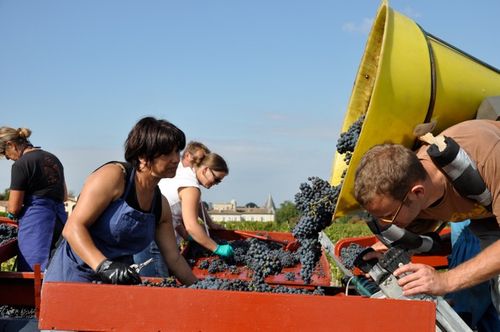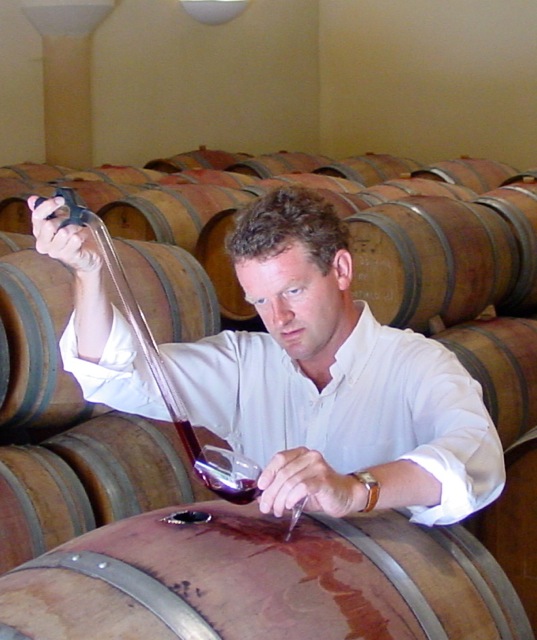With the Bordeaux crop now safely in the fermenting tanks, it seems certain that 2009 will be an exceptional vintage.
Here, Liv-ex is opening up the blog to Gavin Quinney, a local grower and winemaker, for an insider's view on 2009.
Gavin was not one of the lucky Bordeaux growers this year. His vineyard at Château Bauduc, where for ten years he’s been making house wines for Gordon Ramsay and Rick Stein, was hit by two hailstorms in May, trashing much of the crop. (He did recover, in part, by leasing more vines.)
An experienced taster, Gavin has covered the Primeurs for Wine & Spirit magazine – and latterly, Harpers Wine & Spirit Trades Review – since the 2005 vintage.
—
“Exceptional”. That’s the refrain at the leading châteaux in Bordeaux in 2009. Since mid-June, it has been warm, dry and sunny, and the glorious weather in the last ten days of September and the first week of October has allowed the top estates – on both Banks – to pick their Merlot and Cabernets in perfect condition.
Christian Moueix was very enthusiastic as he completed the harvest at Pétrus on 1st October. The vintage is “truly exceptional”, he said. “The word this year is fruit – it’s unbelievable the feeling of the fruit that we have. Ripeness, not over-ripeness – even if the alcohol level is very high – but everything is so fruity, even in the lesser blocks. I don’t speak just of Pétrus, of course, but for all our vineyards in Pomerol. Usually I am rather pessimistic but this year everything went so perfectly that I could not dream of better weather all along the year.”
“It’s a little bit too early to talk about the vintage,” Hubert de Boüard told me ten days later, as he finished the Merlot and started his Cabernet Franc at Château Angélus, in St-Emilion. “But as a winemaker for 25 years, it’s really exceptional.”
Across the Gironde in Pauillac, Philippe Dhalluin, the Technical Director for Mouton Rothschild, was equally optimistic as they harvested their Cabernet Sauvignon from 1st October onwards – just as they did at Lafite next door. Both estates had picked their Merlot during the week before. “It’s clearly exceptional – that’s obvious”, he said, “because of the quality of the grapes, the richness, the purity, the extraordinary weather – not a drop of rain.”
Fortunately, the protracted dry spells were preceded by a very wet April and average rainfall in May, which helped replenish the water levels. The weather since has been superb – not too hot, with just the occasional smattering of rain. And, unlike the stifling summer heat of 2003, the nights have been quite cool.
Would the sunshine continue into September and into early October for the harvest? Yes was the answer, with the only serious rainfall coming mid-month, and especially over the weekend of 19th September. The rain then was light in the Médoc but quite heavy on the Right Bank, especially in Pomerol and parts of St-Emilion. This, however, benefited some water-stressed vines.
The last ten days of September and first week of October were extraordinary, with record temperatures in early October, providing ideal conditions in the final days leading up to and during the harvest.
Until 10th October, I had seen no rot to date on any red grapes at the important châteaux. Those properties still holding out for more maturity have run the risk of rot, as it was more humid from 8th to 12th October although the forecast from the 13th onwards is fine again – which also bodes well for the sweet whites.
What about the red grapes, and the wines they’ll produce? Clearly, alcohol levels are potentially very high, especially for Merlot, which has higher sugars than the Cabernet Sauvignon as you’d expect.
The potential in the grapes, which are noticeably consistent in size and true to type, is huge. The flavours are explosive, and with massive colour, thick skins and powerful but ripe tannins, there’s great excitement about the quality of fruit. Of course, careful extraction will be needed and the level of alcohol is the one possible fly in the ointment. Some Merlot has come in at over 15°, with the norm – for major estates – being around 14° to 14.8°, and even these numbers could be conservative. Balance is crucial, yet my impression – on tasting the grapes – is that the top producers should achieve this. The PH levels are good and the tannins are very fine. But they’ll be big wines.
Levels of alcohol should be slightly less of a concern for the many châteaux of the Left Bank, with their Cabernet Sauvignon coming in from 12.4° to 13.8° – with many blocks much higher than usual. From what I’ve tasted in Pauillac, St-Julien and Margaux, the Cabernet Sauvignon on the Left Bank is outstanding. Meanwhile, much of the Cabernet Franc of the Right Bank is very good – “the best I’ve ever picked”, according to Otto Rettenmaier of La Tour Figeac, on the borders of St-Emilion and Pomerol.
Yields too are good, but these have been tempered by the fact that the skins are thick and there’s less juice. (It’s not difficult to see which side of the equation the producers might focus on when it comes to discussing prices.)
Only those vineyards which were hit by hail in May have very low yields, and as far as the very top growths are concerned– most of the damage was in the stalls, not the royal circle – the hail was limited to relatively few vineyards in St-Emilion, such as at Château Trottevielle.
As ever, it’s interesting to compare with other vintages, even if every vintage is unique. A mythical blend of 1982, 1989 and 1990 has been mentioned, with 1947 being Christian Moueix’s choice. And as Hubert de Boüard pointed out, the legendary Cheval Blanc 1947 was close to 15° alcohol.
Incidentally, they certainly didn’t have the kit back then. The news in 2009 could have been the installation of many new, highly sophisticated ‘optical’ sorting machines on trial this year, such as at Mouton Rothschild, Léoville Las Cases and Pétrus. These rejected very little as 99.9% passed through with flying colours. So whilst these huge bits of equipment were, in my opinion, almost superfluous this year, it was an uncomplicated, relaxed vintage in which to test them. The benefit will no doubt come in the years ahead, with slightly less than perfect grapes.
In summary, 2009 is clearly an extraordinary vintage, and it’ll be a surprise if any of the leading merchants decide not to come for the Primeur tastings next Spring. But don’t forget your toothbrush.
—
Gavin Quinney is filming a series of videos about the ‘Making of Bordeaux 2009’, further details to follow.







